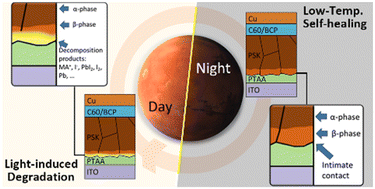Low-intensity–low-temperature stability assessment of perovskite solar cells operating on simulated Martian surface conditions†
Abstract
Immigration to Mars, which is expected to be powered mainly by photovoltaics, is one of the greatest dreams of humanity. However, the extreme temperature difference and high-energy cosmic radiation on the surface of Mars make it difficult for conventional photovoltaics to operate steadily over time. With their advantages of being lightweight, having a high irradiation tolerance, and an outstanding power conversion efficiency (PCE), perovskite solar cells (PSCs) have shown themselves to be a promising candidate for Martian applications. In this study, we simulated the low-intensity–low-temperature (LILT) environment of the Mars surface, and monitored the in situ device performance of PSCs. Surprisingly, the device PCE was not only maintained at a high level but was even improved slightly. Further investigation revealed that the self-healing effect of perovskites under LILT conditions could be attributed to the light-induced decomposition of the perovskite film and the β-phase perovskite recrystallization process at the perovskite/hole transport layer interface. Interfacial β-phase perovskites are stable at low temperatures, which can facilitate charge extraction and protect the perovskite bulk from long-term light damage. This study demonstrated the feasibility of PSCs and provides a reference for Martian applications.



 Please wait while we load your content...
Please wait while we load your content...